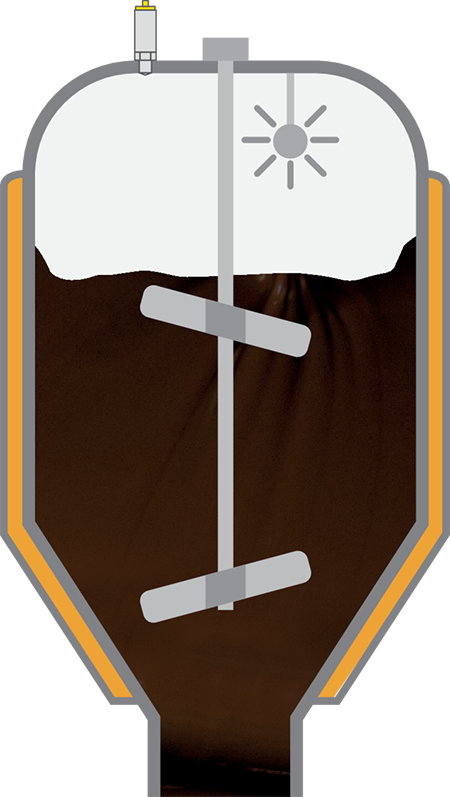Radar technology can now be used even in small containers
The big advantage of radar technology is its ability to measure under different and changing process conditions across a variety of media. However, up until now, the use of the sensors in small vessels was very limited, because sensors were not available with the necessary small process fittings as well as not achieving the accuracy and measurement certainty required at very close range.
Guided radar has been used as an interesting alternative, but it quickly reaches its limits in applications with very strong product movement, agitators and the very high demands on hygiene.
Although the close range of radar sensors is not limited by a dead band, the previous technologies were often subject to limitations because the interfering signals from the antenna system could cause accuracy problems or even obscure the echoes from the product surface.
The solution
The high frequency of VEGAPULS 64 not only facilitates the use of significantly smaller process fittings, it also ensures significantly better measurement performance when the sensor is used in small vessels. The large sensor bandwidth produces very narrow echo signals, which enables a significant increase in measurement accuracy, even at close range.
The use of new antenna technologies for 80 GHz frequency range has assisted in reducing the interfering signals at close range – the result is significantly higher measurement reliability right in front of the antenna. Due to these significant performance enhancements, VEGAPULS 64 can also be used in smaller vessels.
The benefits
- Accurate, universal radar technology can be used in very small vessels
- Non-contact, hygienic and wear-free measurement
- Easy replacement of existing technology thanks to the process fittings
Expert tip:
The strength of the reflected signal is determined by the medium and the size of the antenna. Level measurement directly in front of the antenna is more challenging when the medium reflects poorly and the antenna is very small. When measuring oil products with a ¾" antenna system, it is a good idea to maintain a minimum distance of 10 - 15 cm which can be achieved with a stand-off nozzle, but if larger process fittings are used, this distance can be considerably shorter.
Applications
Zbiornik IBC (metalowy)
Pomiar poziomu cieczy w zbiornikach transportowych
W wielu procesach produkcyjnych w przemyśle chemicznym małe ilości różnych substancji chemicznych są potrzebne, aby poprawić właściwości określonych produktów. Takie media są dostarczane na linię produkcyjną w małych zbiornikach transportowych. Dokładny pomiar poziomu pozwala zapewnić ciągłość dostaw komponentów do trwającego procesu.

Bezpiecznie
Precyzyjny pomiar aż do dna zbiornika
Ekonomicznie
Szybka i łatwa instalacja sondy
Komfortowo
Wizualizacja wartości pomiarowych
Zbiornik w rozlewni
Pomiar poziomu napełnienia zbiornika w rozlewni
Małe zbiorniki o wysokości około 1 m i średnicy 60 cm w zakładzie produkcyjnym zasilają głowice napełniające. Paleta produktów obejmuje zarówno dżemy, masło orzechowe, jak i czekoladowy krem do smarowania pieczywa, przy czym występują różnice w zakresie lepkości i temperatur. Gęstość produktu zmienia się przy każdej partii wyrobu. Pomiar poziomu napełnienia jest nieodzowny do optymalnego napełniania słoików.

Bezpiecznie
Pomiar niezależny od gęstości i lepkości
Ekonomicznie
Dokładny pomiar poziomu napełnienia optymalizuje wykorzystanie słoików i medium
Komfortowo
Łatwa instalacja i uruchomienie
Zbiornik magazynowy środka czyszczącego instalacji CIP
Pomiar poziomu napełnienia i poziomu granicznego zbiornika magazynowego na środek myjący instalacji CIP
Czyszczenie instalacji w przemyśle farmaceutycznym odbywa się w ramach zweryfikowanych procesów mycia „Cleaning in place (CIP)”, które zapewniają sterylność zbiorników produkcyjnych. Ług sodowy lub stężony kwas są często stosowanymi środkami czyszczącymi, które przechowuje się w zbiorniku magazynowym instalacji CIP i potem rozcieńcza w zbiorniku produkcyjnym. Pomiar poziomu napełnienia zapewnia optymalne przechowywanie środka myjącego. Sygnalizator poziomu granicznego służy jako zabezpieczenie przed przepełnieniem lub suchobiegiem.

Bezpiecznie
Materiały z dopuszczeniem zgodnie z FDA i WE 1935/2004
Ekonomicznie
Nie wymaga konserwacji
Komfortowo
Łatwy montaż
Eksportuj ten artykuł
Pobierz jako PDFUdostępnij post
Komentarze ({{comments.length}})
{{getCommentAuthor(comment, "Anonim")}} {{comment.timestamp | date : "dd.MM.yyyy HH:mm" }}
{{comment.comment}}






